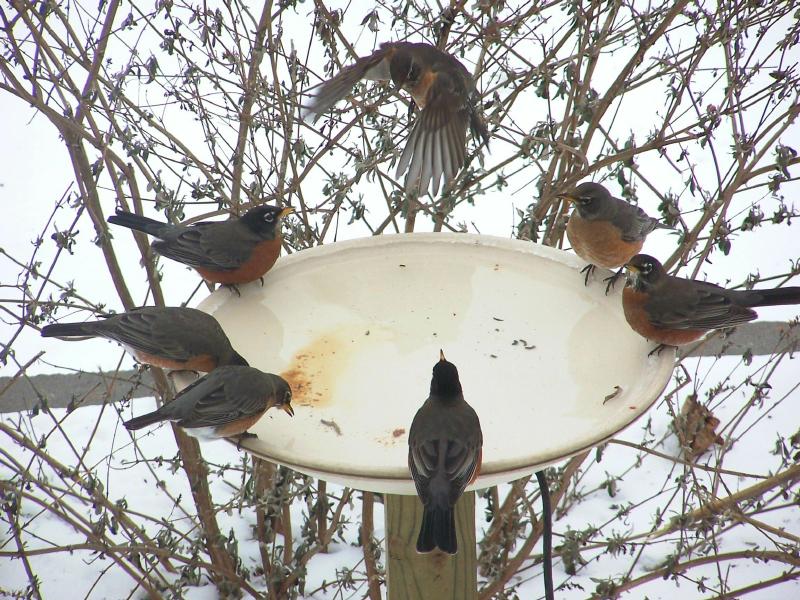Photo Study
In spring and early summer, robins get stressed when robins other than their mate and babies are close. Their blood pressure rises and their hearts beat faster. But in autumn and winter, robins become sociable. They join big flocks. They feed, drink, and roost and hang out close together, as this January photo shows! Go around the bird bath and study the body postures of each bird as one robin flies in. What does each robin's body posture tell you? Then see comments of Journey North's robin expert, Laura Erickson, who helps you figure out what's going on. Next, see our Try This section for fun follow-ups, including how to calculate your own personal space.
 |
|
This
photo was taken Jan. 26, 2004 by Becky Stanton in Gahanna, OH |
- The robin directly in the path of the landing robin is crouching, just in case it needs to take off to avoid a crash.
- Moving counterclockwise from that one, the next two robins are drinking, apparently not concerned at all about the landing bird.
- The next robin seems to be looking at the landing bird, but isn’t crouching, nor in a threatening posture.
- The next one seems to be looking at Becky, taking the photo. Robin eyes are on the sides of their head, and see better when looking sideways than directly. As a matter of fact, that bird may be looking right at Becky with one eye AND the flying bird with the other!
- The last sitting robin (to the right of the landing bird) has its head cocked, looking at the flying bird—but doesn’t seem to be concerned or threatened by it.
- Look at
the cupped wings of the landing robin. This photo captures how a robin
holds its wings in order to brake as it lands. Can you count nine feathers
radiating out from the hand bones on the left wing? These are called
primary feathers. Robins have ten primaries, but one is "vestigial"
(just a tiny little feather).
One
More Thing
When robins take off in flight, they often poop. You can tell by the whiteness
of the bird bath that Becky keeps it clean. But when so many robins are
coming to the bird bath, she probably has to hose it out a lot!
Try This! Journaling Question & Link to Activity
- What are some advantages robins gain by flocking together?
- As you watch robins around feeders and birdbaths, on wires or on the ground. look for their individual distance. Write your observations in your journal and be sure to include the date. Over several months, what changes do you notice about robins and their individual distance?
- Have you noticed that animals—from cows in a pasture to birds on a wire—maintain space around each other? People do it too. We call it personal space, and scientists call it individual distance. How much do you need? Predict your answer, then figure it out:


